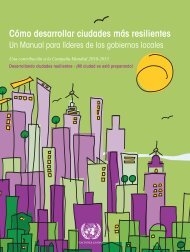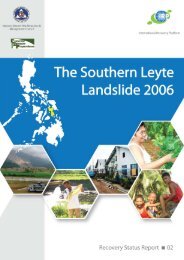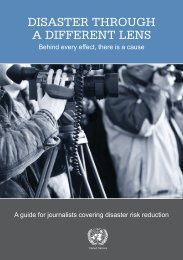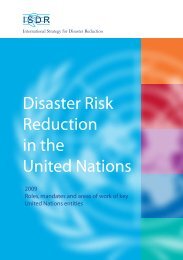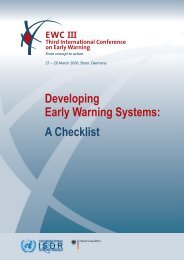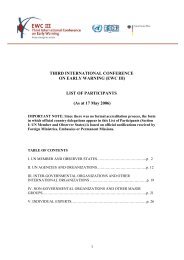Overview of Local Government Self-Assessment Tool (LGSAT
Overview of Local Government Self-Assessment Tool (LGSAT
Overview of Local Government Self-Assessment Tool (LGSAT
You also want an ePaper? Increase the reach of your titles
YUMPU automatically turns print PDFs into web optimized ePapers that Google loves.
Table A.2: Key Questions for <strong>Self</strong>-<strong>Assessment</strong> based on the ‘Ten Essentials for Making Cities<br />
Resilient’<br />
The column ‘Ten Essentials’ includes the number(s) <strong>of</strong> the HFA priority(ies) to which each Essential corresponds. The<br />
numbers following each ‘Key Question’ in this table [i.e.: 1.1] point to the corresponding HFA Core Indicators in table A.3.<br />
The full system – aligning ‘key questions’ and ‘core indicators’ – is available online, with additional guidelines.<br />
TEN ESSENTIALS<br />
ESSENTIAL 1:<br />
Put in place<br />
organization and<br />
coordination to<br />
clarify everyone’s<br />
roles and<br />
responsibilities<br />
[HFA PRIORITY 1]<br />
ESSENTIAL 2:<br />
Assign a budget and<br />
provide incentives for<br />
homeowners, lowincome<br />
families and<br />
the private sector to<br />
invest in risk<br />
reduction<br />
[HFA PRIORITIES 1<br />
AND 4]<br />
ESSENTIAL 3:<br />
Update data on<br />
hazards and<br />
vulnerabilities,<br />
prepare and share<br />
risk assessments<br />
[HFA PRIORITIES 2<br />
and 3 AND 4]<br />
KEY QUESTIONS PER ESSENTIAL<br />
[Numbers following each question indicate references to HFA Core Indicators]<br />
1. How well are local organizations (including local government) equipped with capacities<br />
(knowledge, experience, <strong>of</strong>ficial mandate) for disaster risk reduction and climate change<br />
adaptation? [1.1]<br />
2. To what extent do partnerships exist between communities, private sector and local<br />
authorities to reduce risk? [1.1]<br />
3. How much does the local government support vulnerable local communities (particularly<br />
women, elderly, infirmed, children) to actively participate in risk reduction decision making,<br />
policy making, planning and implementation processes? [1.3]<br />
4. To what extent does the local government participate in national DRR planning? [1.4]<br />
5. To what extend does the local government have access to adequate financial resources to<br />
carry out risk reduction activities? [1.2]<br />
6. To what degree does the local government allocate sufficient financial resources to carry<br />
out DRR activities, including effective disaster response and recovery? [1.2]<br />
7. What is the scope <strong>of</strong> financial services (e.g. saving and credit schemes, macro and microinsurance)<br />
available to vulnerable and marginalised households for pre-disaster times?<br />
[4.2]<br />
8. To what extent are micr<strong>of</strong>inancing, cash aid, s<strong>of</strong>t loans, loan guarantees, etc. available to<br />
affected households after disasters to restart livelihoods? [4.2]<br />
9. How well established are economic incentives for investing in disaster risk reduction for<br />
households and businesses (e.g. reduced insurance premiums for households, tax holidays<br />
for businesses)? [4.3]<br />
10. To what extent do local business associations, such as chambers <strong>of</strong> commerce and<br />
similar,support efforts <strong>of</strong> small enterprises for business continuity duringand after<br />
disasters? [4.3]<br />
11. To what degree does the local government conduct thorough disaster risk assessments for<br />
key vulnerable development sectors in your local authority? [2.1]<br />
12. To what extent are these risk assessments regulary updated, e.g. annually or on a bi annual<br />
basis? [2.1]<br />
13. How regularly does the local government communicate to the community information on<br />
local hazard trends and risk reduction measures (e.g. using a Risk Communications Plan),<br />
including early warnings <strong>of</strong> likely hazard impact? [3.1]<br />
14. How well are local government risk assessments linked to, and supportive <strong>of</strong>, risk<br />
assessments from neighbouring local authorities and state or provincial government risk<br />
management plans? [2.4]<br />
15. How well are disaster risk assessments incorporated into all relevant local development<br />
planning on a consistent basis? [2.1]






